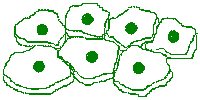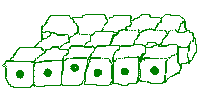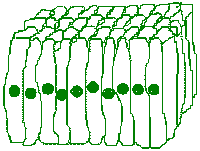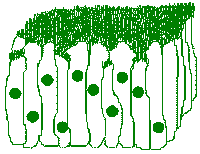 There are many other examples of negative feedback loops in the world around
us, many of which aren’t even biological. Consider what happens when you
flush a toilet.
There are many other examples of negative feedback loops in the world around
us, many of which aren’t even biological. Consider what happens when you
flush a toilet.
Now that we’ve covered some genetics, we’re going to spend the rest of the quarter talking about anatomy and physiology. Anatomy is the study of the various body parts and their names and locations. Physiology is the study of the functioning of the organs and systems that make up our bodies; the various processes our bodies do and how they do them. We will start first with some general information, then discuss each body system. The cells in our bodies make up tissues, groups of the same kind of cells with a common structure and function. Examples of tissues include muscle, skin, or bone. Histology is the study of tissues. Groups of different types of tissues are arranged together to form organs. For example, the stomach includes mucus membrane tissue, muscle tissue, a layer of tissue lining the abdomen, etc. Organs, in turn, are grouped into systems. The systems in our bodies include:
| Organ-Systems | ||
|---|---|---|
| cardiovascular (circulatory) digestive endocrine excretory (urinary) |
immune integumentary (skin, hair, nails) lymphatic muscular |
nervous reproductive respiratory skeletal |
A very important concept for the well-being of our bodies is homeostasis, which is the ability of an animal to maintain a constant internal environment. Homeostasis encompasses many body processes. We probably think of maintaing a constant body temperature, but homeostasis also includes water balance, which is influenced by the amount of water in the external environment and whether that is fresh or salt water. Water balance is regulated through such things as thirst and urination. Other factors which are under regulation include internal salt concentration, pH (despite the fact that cellular respiration creates CO2 which dissolves in our blood to make carbonic acid, the pH of our blood is buffered at 7.4 or we would die.), nutrients and various chemicals (regulated by factors like blood sugar level, feelings of hunger, or cravings for certain foods). Homeostasis is controlled by feedback loops (positive and negative), most of which are negative feedback loops. An example of a positive feedback loop (this particular one is not involved in homeostasis) is the process of giving birth to a baby. Labor contractions push the baby against the cervix causing the cervix to dilate. This, in turn, triggers the production of oxytocin, a hormone which triggers stronger contractions. A negative feedback loop works in the opposite direction from what it is trying to accomplish. An example of a negative feedback loop involved in homeostasis is maintenance of body temperature. As a person’s body gets too hot, (s)he begins to sweat in an attempt to lower the temperature. If someone’s body is too cool,(s)he will begin to shiver in an attempt to increase the temperature.
![]()
 There are many other examples of negative feedback loops in the world around
us, many of which aren’t even biological. Consider what happens when you
flush a toilet.
There are many other examples of negative feedback loops in the world around
us, many of which aren’t even biological. Consider what happens when you
flush a toilet.
until the water reaches a normal level,
again. Click the toilet tank to the left to see an animation of this
process.

People at a Picnic, around a Bonfire
Consider just a few of the things that are happening in this
picture:
during the daytime, while people are active...
Out of that list, there are several of these “reactions”
that are examples of negative feedback loops:
increase in body temperature
→ increased sweating → decreased body temperature
decrease in body temperature → shivering → increase in body
temperature
and, slightly more complex,
decrease in body fluids
→ increase in thirst → increase in fluid consumption →
increase in body fluids
Notice that in each case, a change in a particular body condition triggers a
reaction which, in turn, brings about the opposite change in the body
condition which triggered it. These are all examples of negative feedback
loops, processes in which the “feedback” sends the process in the
opposite direction from that in which it was initially headed. Our
bodies use many types of negative feedback loops to maintain homeostasis.
There are four types of tissue cells in our bodies.
| These are simple squamous cells. | These are simple cuboidal cells. |
 |
 |
| These are simple columnar cells. | These are stratified squamous cells. |
 |
 |
| The trachea is
lined with
pseudostratified
ciliated columnar epithelium. Smoking first paralyzes the cilia, then destroys cells. If a person stops smoking, the damage can heal and the cells grow back. |
|
 |
|